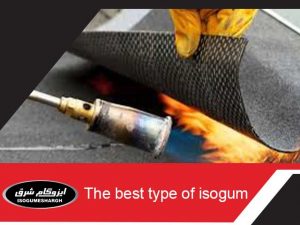What are geomembranes?
Geomembrane is made of impermeable polymer sheets and is placed directly on the soil and prevents water from leaking into the soil. Geomembrane sheet is impermeable and is a good alternative to the old methods of insulation and is used as insulation in many places without profitable substructure.
Despite the geomembrane technology, they are a good alternative to the old methods such as cement and concrete and are put together by thermal welding or other methods. Long life and good flexibility have made this product widely used in industries such as oil, chemical, gas, water and wastewater, mining, fisheries, agriculture and landfill.
Disadvantages and advantages of geomembranes
Disadvantages and advantages of geomembranes
Geomembrane, like any other product, has advantages and disadvantages, the advantages of which outweigh its disadvantages, which are:
High installation and execution speed
Eliminate leaks and prevent water wastage
Very durable and durable insulation
Reduce costs compared to the old methods
Do not stick moss and sludge to the pool cover
Extremely high resistance to biological and natural agents
Resistant to sunlight and all kinds of weather conditions
Shelf life about 20 to 40 years
High resistance to insect damage
In case of any problem, it can be repaired
No reaction against chemicals
Installation of geomembranes
Installation and implementation of geomembranes
The first step in installing and executing geomembranes is excavation. In some cases, during excavation, we encounter layers of sand and granular soil, and the soil surface must be flattened and the rock layers must be removed in contact with the geomembrane. Because the presence of pebbles can damage the geomembrane sheets. Some people use soft soil to level the ground and pour soft soil in and around the pool.
You can use mud straw or layers called geotextiles to base the pool. After the pool leveling process is completed, the implementation of the membranes begins. To implement geomembranes in earthen ponds, its slope should be such that this product is not involved in lateral pressure of the soil from the pool so that no fall or destruction occurs during the operation of the pool.
In the next step, it is time to install geomembranes. Wind speed, weather conditions and ambient temperature affect the installation of geomembranes. Often, especially in small pools, the geomembrane sheet is cut on the flat surface of the pool and off-project and then attached to the pool.
Geomembrane pool
Geomembrane pool is the same as other water storage pools. Soil pools are usually used for geomembranes and in cases where the pool soil is unsuitable for geomembranes, it needs infrastructure. Construction of recreational ponds, fish ponds Water storage ponds in agriculture are made of geomembrane sheets. The water inside these pools is well maintained and does not leak at all. Among the steps of installing a geomembrane pool are:
Mapping and reviewing conditions
Pool design based on its dimensions
Drop the pool on the ground
Excavation and embankment operations
Pool bedding operation
Piping in the desired location
Calculate the amount of membranes required
Pool dewatering and testing it
Application of geomembranes
Application of geomembranes
Construction of agricultural and recreational ponds, fish farming and water storage
Insulate the green roof
Insulation of water channels
Insulation of the foundation
Insulation of petrochemical tanks
Insulation of industrial and urban treatment plants
Insulate seals and dams
Isolation of tunnels and mines
Covering artificial lakes
Closing closed tanks and water reservoirs
To protect concrete against harmful substances
In nuclear facilities and refineries
Disposal of hazardous and radioactive waste
Prevent the smell of garbage holes
Prevent the infiltration of waste into the underground layers
Agricultural pool geomembranes
Today, due to the good advantages of geomembrane sheets, they have received more attention than concrete and other materials for building pools. These sheets are very resistant to cold, heat and sunlight and can even withstand temperatures up to positive 80 degrees and negative 70 degrees. Geomembranes are 100% impermeable and you will not see any leakage in it.
Geomembrane pool
What is the lifespan of geomembranes?
The most important criterion for calculating the lifespan of geomembranes is long-term oxidant degradation. Initiation of the oxidation reaction reduces the mechanical and physical properties, resulting in inefficiency or damage to the geomembrane. The oxidation reaction occurs by the formation of a hydroperoxide group, the reaction with oxygen, the formation of a free radical, and the removal of a hydrogen atom from a polymer chain. The hydroxide group is unstable and will decompose easily and lead to the formation of free radicals, thus increasing the rate of polymer degradation.
Lifespan of geomembranes
The stages of the oxidation reaction include the beginning, the growth and the end. Degradation of geomembranes also occurs due to the release of antioxidants, degradation and reduction of mechanical properties and oxidant induction time. Decreased mechanical properties by decreasing the rate of increase in failure length, slight increase in yield stress, stress at break point and decrease in increase in yield at yield point. The time it takes for the mechanical properties to reach 50% of the initial value is called the life of the geomembrane.
Geomembrane prices
Geomembranes have variable prices and factors such as area, material, quality, production method, thickness and تاثیر affect the quality of geomembranes. When buying geomembranes, it is recommended to first consider quality and then price. To ensure the quality of geomembranes, you can get this product from Izogam Shargh.
Price per square meter of geomembrane
Geomembrane pricing is based on square meters. The price of each square meter is calculated according to the thickness and volume of the order. The thicker and larger the geomembrane, the higher the price. For information on the price per square meter of geomembrane, contact the numbers available on the site.
Mashhad Geomembrane Factory
Mashhad Geomembrane Factory is one of the largest factories producing geomembrane sheets, which is operating widely and around the clock. This factory produces the best geomembranes on the market and the quality of the company’s products is fully guaranteed. Also, the direct supply of Mashhad geomembranes will reduce the purchase cost of this product.

